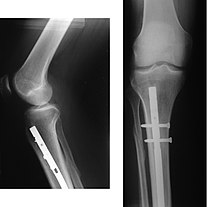

An intramedullary rod, also known as an intramedullary nail (IM nail) or inter-locking nail or Küntscher nail (without proximal or distal fixation), is a metal rod forced into the medullary cavity of a bone. IM nails have long been used to treat fractures of long bones of the body. Gerhard Küntscher is credited with the first use of this device in 1939,[1][2] during World War II, for soldiers with fractures of the femur. Prior to that, treatment of such fractures was limited to traction or plaster, both of which required long periods of inactivity. IM nails resulted in earlier return to activity for the soldiers, sometimes even within a span of a few weeks, since they share the load with the bone, rather than entirely supporting the bone.[3]

The oldest intramedullary nail was found in the left knee of a mummy named Usermontu, the remains of an Egyptian man from more than 3,500 years ago. Researchers believe the pin was inserted after the man's death, but before his burial.[4]
- ^ "AO Dialogue 2206: The magazine of AO community" (PDF). AO Foundation. p. 42. Archived from the original (PDF) on 2015-01-21. Retrieved 2013-03-12.
- ^ Bong, Matthew R.; Koval, Kenneth J.; Egol, Kenneth A. (2006). "The History of Intramedullary Nailing" (PDF). Bulletin of the NYU Hospital for Joint Diseases. 64 (3/4). NYU Hospital for Joint Diseases: 94–97. PMID 17155917. Archived from the original (PDF) on 2015-01-21. Retrieved 2013-03-12.
- ^ "Wheeless' Textbook of Orthopaedics - Intramedullary Nailing of Femoral Shaft Frx". Duke Orthopaedics. Retrieved 2011-08-04.
- ^ Snow, Karen (June 1996). "BYU professor finds evidence of advanced surgery in ancient mummy". BYU Magazine. Brigham Young University. Retrieved May 27, 2015.